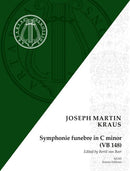| 作曲者 | Joseph Martin Kraus (1756-1792) |
| タイトル | Symphonie funebre in C minor VB 148 |
| 出版社 | Artaria Editions |
| 楽器編成 | orchestra |
| 品番 | mds9790674515375 |
| 校訂者 | Bertil Van Boer |
| 出版番号 | AE341 |
| ISMN | 979-0-67451-537-5 |
| サンプル | http://assets.schott-music.com/Assets/Product/0/71/83/718343/500_MAVE/BSPSEITEN/AE341-01.jpg::;http://assets.schott-music.com/Assets/Product/0/71/83/718343/500_MAVE/BSPSEITEN/AE341-02.jpg::;http://assets.schott-music.com/Assets/Product/0/71/83/718343/500_ |
This edition is based upon the principal official score (and parts) of the entire funeral music for Gustav III, now in Stockholm at the Statens Musiksamlingar (Operansbibliotek Kyrkomusik 38). The autograph has been lost, possibly because it was used as a model for the publication of the funeral music in piano reduction by Olof hlstrm in May of the same year and subsequently discarded. The main score was written for the services themselves in the hand of the official state music copyist, Friedrich Gottlob Ficker, and were probably used by Kraus as his conductor's score. As with most of Kraus's music, there is an almost obsessive detail devoted to matters of performance, including absolute and precise markings, articulations, and ornaments. These have been followed without question, even if, on occasion, they are dissimilar from parallel passages. Only in bar 29 in the Violin I part has a missing slur been added. As noted above, the performance of the work within its original context was to divide it in half; more modern performances may wish to take a brief pause between the second and third movements to simulate this division. The beginning of the third and fourth movements have had a pianissimo added as a dynamic marking, as the principal source is clear that this level of sound should be carried over from the final mark in the second movement. In bars 29-30 of the fourth movement, the term "ad libitum" for the solo horn part is used to indicate a deliberate statement of the cadential notes, not a cadenza. In bar 34, the tutti violoncelli have been given a part colla parte with the contrabass, following the official parts; the source merely has the solo part, with no indication how the other cellos in the section continue. In addition, in the fourth movement, the viola parts have been divided throughout in order to achieve clarity of line for those sections where the divisi results in substantially different lines.
Bertil van Boer



